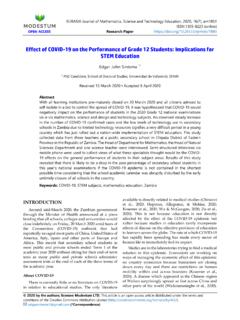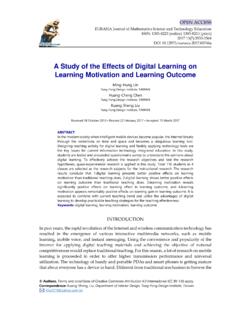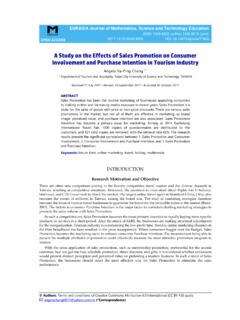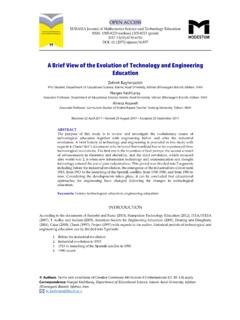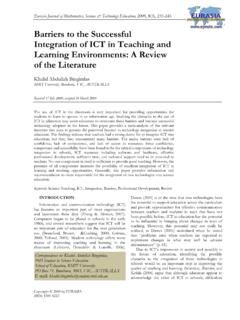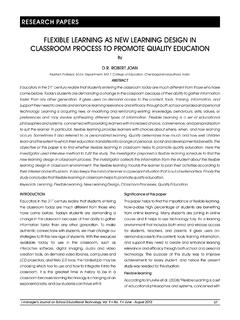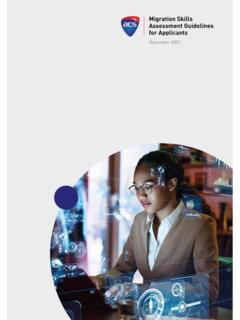Transcription of The ICT Facilities, Skills, Usage, and the Problems Faced ...
1 OPEN ACCESS EURASIA Journal of Mathematics Science and technology Education ISSN: 1305-8223 (online) 1305-8215 (print) 2017 13(8):4987-4994 DOI: Authors. Terms and conditions of Creative Commons Attribution International (CC BY ) apply. Correspondence: Aishah Siddiquah, Institute of Education, Lahore College for Women University, Shadman, Jail Road, Lahore, Pakistan. The ICT Facilities, Skills, Usage, and the Problems Faced by the Students of Higher Education Aishah Siddiquah Lahore College for Women University, Lahore, PAKISTAN Zeema Salim Lahore College for Women University, Jhang Campus, PAKISTAN Received 21 June 2017 Revised 21 July 2017 Accepted 21 July 2017 ABSTRACT The present survey research was aimed at identifying the ICT facilities, skills, usage, and the Problems Faced by the students of higher education while using ICT.
2 The population of the study comprised the students of public sector universities of Lahore, Pakistan. Instrument was developed by the first author. About 250 students were selected from three public universities. Descriptive statistics were used to analyze the data. The findings revealed that the students have computers and Internet facilities at home and universities. They are expert at simple skills like MS Word, MS Power Point, Searching and Browsing at Internet, Social networking, Email, File attachment, and Computer games but are less skilled or poor on other skills like using digital library, discussion forums, and Blogs.
3 Students spend more time on computers for recreational and other purposes than for academic purpose. They believe that the use of ICT supports their learning. Slow speed of computers, signal problem in Internet, virus threat, poor working condition of computers, load shedding, and lack of access of Internet are the Problems Faced by the majority of the students. The universities should invest more on improving the infrastructure to address the ICT related Problems of students at the universities. Keywords: ICT ( information & communication technology ), ICT facilities, ICT skills and programs, usage of ICT for learning, higher education INTRODUCTION Ultimate power of technology is the information and the communication .
4 ICT is vital for social life, business and economy, to meet the demands of modern information society, and for the progress of education (Aduwa-Ogiegbaen & Iyamu, 2005). Use of ICT in education improves the quality and the quantity of education (Balasubramanian et al., 2009) and causes better innovative, creative and cognitive thinking, higher productivity, efficiency, and educational outcomes (Adeosun, 2010). ICT facilitates both instructional and learning process (Jung, 2005) and has a great influence on teaching and learning at higher education.
5 It provides opportunity for personalized, flexible and asynchronous learning and shifts the learning from teacher centered to student centered and hence is a catalyst for reforms about classroom, educational institute, community and system (Youssef & Dahmani, 2008). It enhances the learning of the students, helps the students to learn new skills set, promotes social mobility, helps the citizens to compete in a worldwide economy, and thus has a multiplier effect across the education system (UNESCO, 2014).
6 A. Siddiquah & Z. Salim / ICT Facilities, Skills, Usage, and the Problems 4988 information communication technology (ICT) presents the material through multiple stimuli like sounds, images, and movement thus catering the needs of psychomotor, visual, and affective learners (Haddad & Jurich, 2002). Radio-assisted instruction (RAI), Television-assisted instruction (TAI), Computer-assisted instruction (CAI), Internet-assisted instruction (IAI) are some of the dimensions of ICT-assisted instruction (UNESCO, 2014). Radio and television have been used for educational purpose for a long time.
7 However, computer affected the educational process more than anything else. In addition to audio and visual sense, computer activates the sense of touch of the user as well. It provides the opportunity of higher interaction to the users for the development of their individual, creative, and intellectual abilities. Radio and television are now considered comparatively traditional technologies in education system as students remain passive learners while using these. Computers, however, provide more productive and innovative instruction and learning to enhance the intellectual and creative potentials of the students in today s information society (Aduwa-Ogiegbaen & Iyamu, 2005).
8 Therefore, computer has been integrated in teaching faster than the previous audio visual technologies (Balasubramanian et al., 2009). Computers and Internet offer excellent and plenty opportunities to the students through the use of text, graphics, multicolor images, motion, and audio for the development of their creative talents and high quality learning. Computer offers more learner centered instruction, independent investigation, personalized activities, and teamwork. It offers a variety of contents and symbolic modes to the leaner and acts as a partner and tutor who interacts with a learner thus offering opportunity for individualized learning to the students.
9 Internet is playing the major role in the dissemination of information and knowledge in this global village (Aduwa-Ogiegbaen & Iyamu, 2005). Study from Nigeria showed that the lack of ICT resources and poor infrastructure prevent the full implementation of ICT in education (Adeosun, 2010). Advanced forms of ICT assisted instruction including computers and Internet assisted instructions require proper infrastructure including substantial computers and Internet resources. Computers available to educational institute contain computers both for instructional and administrative purposes.
10 In developing countries, fewer computers are available for instructional purposes. The term Learner Computer Ratio (LCR) is used to describe the number of learners using a computer for instructional purpose in an educational system. Developed and developing countries deploy computers differently in their educational institutes. Developing countries establish computer labs, whereas developed countries diversely State of the literature Computer and Internet affected the educational process more than the previous educational technologies.



